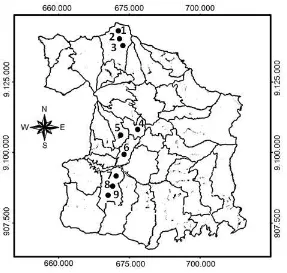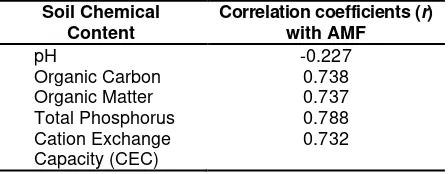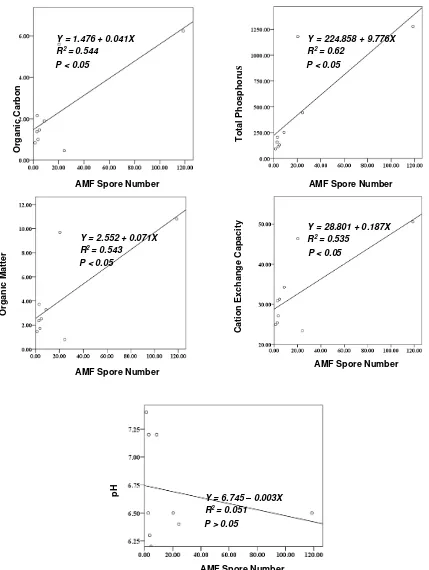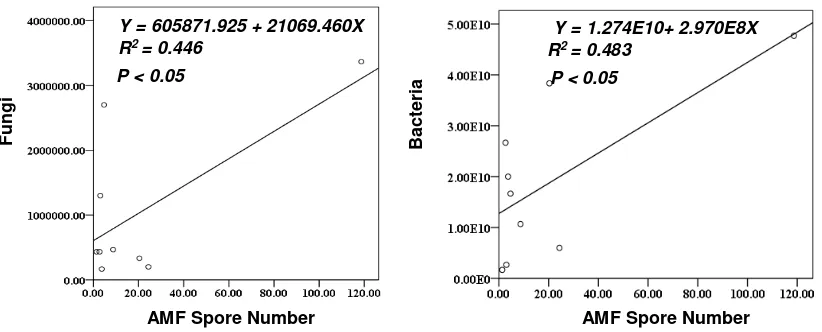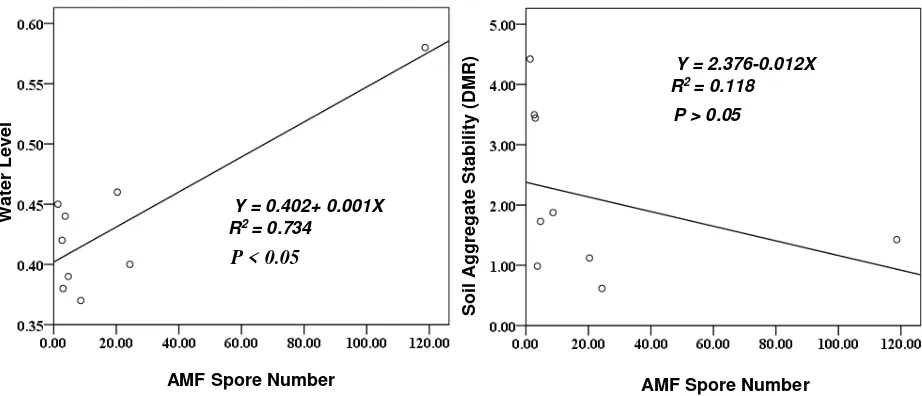ARBUSCULAR MYCORRHIZA FUNGI AS AN INDICATOR OF SOIL FERTILITY
Muhammad Akhid Syib’li*), Anton Muhibuddin and Syamsuddin Djauhari Faculty of Agriculture University of Brawijaya
Jl. Veteran Malang 65145 East Java Indonesia
*)Corresponding author phone: +62341 575843 E-mail: [email protected]
Received: November 23, 2012/ Accepted: April 25, 2013
ABSTRACT
Arbuscular mycorrhizal fungi (AMF) are ubiquitous organism that forms association with the root of most terrestrial plants. AMF association also influence soil fertility through the enhancement of chemical, biological and physical content. In this study, we enumerated AMF spores from rhizosphere of Tithonia difersivolia as an indicator of soil fertility. The results showed that the most fertile soil had the highest AMF spores density. This research has confirmed that AMF has high interaction with organic carbon, organic matter, total phosphorus, cation exchange capacity, water level, soil fungi and soil bacteria. Partial regression analysis revealed the mathematic equation for their interaction. This equation used the abundant of AMF spores as an indicator for chemical, biological and physical fertility of the soil. Keywords: Arbuscular mycorrhiza fungi (AMF),
indicator, soil fertility, Tithonia difersivolia
INTRODUCTION
Arbuscular mycorrhiza fungi (AMF) are critical symbionts in the association with more than 80% of terrestrial plant (Smith and Read, 1977). They are developed in the root tissue to focus on their role to increase plant growth and yield. AMF (phylum Glomeromycota) are almost certainly the most abundant fungi in the soil (Opik et al., 2008) and also have direct effect on soil structure (Gosling et al., 2006). Many studies have shown that AMF association has multiple benefits to the soil fertility through improving the quality of chemical, biological and physical aspects. This research examines the relationship between AMF spore number and these three fertility aspects.
Malang Raya is located in the East Java, Indonesia, with an extent approximately 4,888.36 km2, and includes Malang city, Batu city and Malang regency. Annual precipitation is around 1,883 mm, average temperature is 24.13o C, and monthly precipitation ranges from 0-200 mm, but from January-October 2012, monthly precipitation ranges from 20-32o C. This area has diverse soil fertility level and different topography from north to south. In the north, Malang Raya has some volcanic mountains, and some Limestone Mountains in the south. These natural conditions cause difference in soil quality in every region especially because the areas near the volcanic mountains have much volcanic material which gives fertility to the soils. Therefore, research about mycorrhiza spore number in every region related to the three aspects of soil fertility interested the authors to conduct this research.
Tithonia difersivolia (Hems) Gray, commonly known as the Paitan in Indonesia, belongs to asteraceae, a shrub species and widely dis-tributed in Malang Raya. This plant has some functions especially as green manure for agricultural plant. In addition, T. difersivolia has tight relationship with AMF and is reported that the degree of colonization by AMF was in average 40% (Sharrock, et al., 2004). Therefore, T. difersivolia was used as material in our current research.
MATERIALS AND METHODS
Study Site
Nine study sites were selected: Sumber-brantas village, Bumiaji sub-district, Batu city (SB) (07045’17.9”S; 112031’52.7”E), with an altitude of 1694 m (Figure 1, No. 1). Sumber-brantas village, Bumiaji sub-district, Batu city (SBB) (07045’17.9”S; 112031’52.7E) with an altitude of 1675 m (Figure 1, No. 2). Bulukerto village, Bumiaji sub-district, Batu city (BBB) Accredited SK No.: 81/DIKTI/Kep/2011
(07051’14.3”S; 112032’20.5”E) with an altitude of 935 m asl.(Figure 1, No. 3). Pakisaji village, Pakisaji sub-district, Malang regency (PPM) (08003’44.7”S; 112035’34.2”E) with an altitude of 393 m asl.(Fig. 1, No.4). Palaan village, Ngajum sub-distrct, Malang regency (PNM) (08006’48.7”S; 112033’05.3”E) with an altitude of 346 m asl.(Fig. 1, No. 5). Jenggolo village, Kepanjen sub-district, Malang regency (JK) (08010’51.6”S; 112032’47.3” E) with an altitude of 292 m asl. (Fig 1, No. 6). Jenggolo village, Kepanjen sub-district, Malang regency (JKM) (08012’41.0”S; 112033’08.7”E) with an altitude of 385 m asl. (Figure 1, No.7). Sempol viallage, Pagak sub-district, Malang regency (SP) (08016’01.3”S; 112030’01.0”E) with an altitude of 446 m asl.(Fig.1, No. 8). Sempol village, Pagak sub-district, Malang regency (SPM) (08016’36.9”S; 112029’44.4”E) with an altitude of 426 m asl. (Figure 1, No. 9).
Collection of Soil Samples
Soil samples in Malang Raya were collected with cluster sampling method. Samples were taken from rhizosphere of T. difersivolia, with the depth of 30 cm from January-October 2012. Each sample was replicated three times. They were placed in the plastic bag and moved to the laboratory. Sub-samples from every replication were used for chemical, biological and physical analysis.
Soil Chemical Analysis
Chemical analysis was used to investigate pH, organic carbon, organic matter, total phosphorus and cation exchange capacity (CEC). pH was calculated in water (1:5), organic carbon and material was measured with Walkey and Black method (Walkey and Black, 1934), total phosphorus was assessed with Olsen method using NaHCO3 pH 8,5 (Olsen et al., 1954) and CEC was assessed with kjeldahl method (Chamuah and Dey, 1982).
Remarks: 1, 2, 3, 4, 5, 6, 7, 8 and 9 represent SB, SBB, BBB, PPM, PNM, JK, JKM, SP, SPM, respectively
Soil Biological Analysis
Dilution plate method was used to calculate the abundance of fungi and bacteria (Waksman, 1922). Sub-sample was diluted up to 10-5 and 10-9 for fungi and bacteria analysis, respectively. Diluted suspension was plate spread on the potato dextrose agar (PDA) and natrium agar (NA) medium for fungi and bacteria, respectively. PDA was added with chlorampenicol (250 mg/liter) before autoclaving to inhibit bacterial growth.
The cultures were incubated at 23o C in the laboratory. The number of colonies/ colony forming unit (cfu) was enumerated after 7 days and 48 hours for fungi and bacteria, respectively.
The abundance of soil fungi and bacteria was calculated to find out the estimation of total number of cfu per gram soil (Pepper and Gerba, 2004). This calculation was performed by the formula:
𝐴 = 101𝑛 × 𝐶
Where:
A : number of cfu, n : dilution factor
C : number of colonies on Petri dish
Soil Physical Analysis
Physical analysis was used to find out aggregate stability and water level of the soil. Aggregate stability and water level of the soil were measured with wet sieving and gravimetric water content method, respectively (Frei et al., 2003; McKenzie and Dexter, 1987).
Extraction of AMF spores
Spores were extracted from 10g air-dried soil from every sample by wet sieving and decanting method (Muhibuddin et al., 2007). AMF Spores were collected on a filter paper and calculated using hand counter under microscope observation (40-time magnification).
Statistical Analysis
The data was analyzed by ANOVA, partial regression and correlation of soil aspect as a dependent variable with AMF as an independent variable. Significant F-tests (P < 0.05) were used for testing differences. All analysis was measured using statistical program SPSS.
RESULTS AND DISCUSSION
Soil Chemical Content Based on AMF Spore Number
AMF spore number was not significantly correlated with pH variable (Table 1), the pH value decreased with the increase of AMF spore numbers (Y= 6.745 – 0.003X; R2 = 0.051). We assumed that pH value from sample 1-9 ranging from 6.2-7.4 (data not shown) still remained in the normal value and did not give significant influence for AMF development in the soil. Table 1. Pearson’s correlation coefficient (r) of
AMF spore number with soil chemical content. Correlation coefficients in bold indicate significance at P < 0.05 (df = 8) Soil Chemical
Content
Correlation coefficients (r) with AMF
pH -0.227
Organic Carbon 0.738
Organic Matter 0.737
Total Phosphorus 0.788
Cation Exchange Capacity (CEC)
0.732
AMF contributed to soil chemical fertility directly and indirectly. According to regression analysis and curves in Figure 2. AMF were positively and significantly correlated with organic carbon, organic matter, total phosphorus and CEC. The mathematic equation revealed
Cardoso and Kuyper (2006) reported that AMF is playing role in the carbon cycling, consequently increasing AMF will increase carbon flow into soil. Interaction between host plant and AMF indirectly affect soil carbon storage (Zhu and Miller, 2003) especially because carbon flow from host to AMF can lose into mycorrhizosphere up to 70% as organic carbon and CO2 (Jakobsen and Rosendahl, 1990). In addition, AMF also produce glomalin which can store soil carbon (Driver et al., 2005). It represents considerable amount about 4 - 5% of total soil carbon, higher than contribution of microbial biomass carbon only ranging from 0.08 – 0.2 % (Rillig et al., 2001). Therefore, not only AMF participate actively in the carbon cycling but also in the soil carbon storage.
Figure 2 shows that the value of organic matter increased as proportionally as the increase in AMF spore number (Y = 2.552 + 0.071X; R2 = 0.543). Ramos et al. (1993) also reported in their research that AMF colonization was positively correlated with soil organic matter in native corn plant. Organic matter improves all aspects in the soil (chemical, biological and physical), therefore its availability is critical. AMF and organic matter are two component that always influence each other. According to Gude et al. (2012) fresh organic input drives soil organic matter dynamic. This material stimulated in a higher amount of fungal and bacteria biomass in decomposing the material (Vaidya et al., 2007). Through this process, nutrient can be available (carbon, phosphate and nitrogen) for plant and organism in the soil ecosystem. As we know that nutrient can be used by AMF to the highest quantities compared with other nutrients. Therefore, it concluded that AMF had very close relationship with P nutrient. Bell et al. (1989) stated that AMF colonization increased significantly as P rate increased from 0-30 kg/ha,and no more significant increase following. This shows that in the certain value of P concentration AMF would increase, but in the more value of P concentration, it could reduce AMF. Grant et al. (2005) supported this statement and stated that AMF symbiosis decreased with increasing tissue P concentration. Therefore in the high P level in the soil, probably it could increase or decrease AMF association depending on the certain quantity of P concentration.
Additionally, AMF also contributed to make P nutrient in the soil available for plant by producing phosphatase enzyme (Kojima et al., 1998). AMF hyphae absorbed the available P, of CEC is strongly influenced by material organic (Lax et al., 1986). For that reason, AMF, which had very close interaction with organic matter (r = 0.738) (Table 1 ; Figure 2), indirectly explains the CEC value. Beside, the involvement of AMF in the decomposing process was absolutely to improve CEC in the soil. CEC showed the available soil nutrient value for plant growth. As we know AMF can absorb and transport cation into plant in much more quantities (Carpio et al., 2009). We presumed in that process AMF could lose the cation and release it in mycorhizos-phere like carbon cases.
O
rga
ni
c
Ca
rbon
AMF Spore Number
O
rga
ni
c
M
a
tte
r
AMF Spore Number
To
ta
l
Pho
s
ph
oru
s
AMF Spore Number
AMF Spore Number
Cati
on
Ex
c
ha
ng
e
Ca
pa
c
ity
AMF Spore Number Y = 1.476 + 0.041X
R2 = 0.544 P < 0.05
Y = 224.858 + 9.776X R2 = 0.62
P < 0.05
Y = 2.552 + 0.071X R2 = 0.543
P < 0.05
Y = 28.801 + 0.187X R2 = 0.535
P < 0.05
Y = 6.745 – 0.003X R2 = 0.051
P > 0.05
pH
Soil Biological Content based on AMF Spore Number
AMF indicated positively were correlated with fungi and bacteria in the soil (Table 2). The abundance of fungi (Y = 605871925. + 21069.460X; R2 = 0.446) and bacteria (Y = 1.274E10+ 2.970E8X; R2 = 0.483) increased with the increase of AMF spore number. Based on this data, we estimated that AMF association promoted the abundance of fungi and bacteria in the soil.
Table 2. Pearson’s correlation coefficient (r) of AMF spore number with soil biological content. Correlation coefficients in bold indicate significance at P < 0.05 (df = 8) Soil Biological
Content
Correlation coefficients (r) with AMF
Fungi 0.668
Bacteria 0.695
Our observation was supported by Fitter and Garbaye (1993) that AMF can modify its interaction with other organisms in the soil, such as root-inhabiting nematodes and fungi, mutualists
and notably nitrogen-fixing bacteria. In the mutualistic interaction, AMF showed its ability to work together with Azospirillum, Pseudomonas and Trichoderma. The result revealed that none of this microbes disturbed AMF establishment. In fact, enzyme that was produced by these three microorganisms increased the abundance of AMF (Vazquez et al., 2000). Another study confirmed the relationship between AMF and Plant growth promoting rhizobacteria (PGPR). PGPR are among soil bacteria that can stimulate AMF to develop and colonize the root. This bacteria also work simultaneously with AMF in enhancing crop yield (Miransari, 2011). In fact, in the mycorrhizosphere were found more bacterial species than in the rhizosphere. This result indicated that natural exudate from root colonized by AMF, probably has potential and contributed in the composition and proliferation of rhizobacteria (Andrade et al., 1997). Even some scientists were tempted to speculate that chemical compounds produced from colonized root by AMF had a wider biological implication in the soil (Garcia-Garrido et al., 2009).
Figure. 3 Regression analysis and curves of AMF spore number with soil biological content AMF Spore Number
Fungi
Y = 605871.925 + 21069.460X R2 = 0.446
P < 0.05
AMF Spore Number
Bac
te
ria
Y = 1.274E10+ 2.970E8X R2 = 0.483
Soil physical content based on AMF spore number
The result of our analysis has revealed the correlation between AMF and soil physical content. It indicated significance only for water level variable but not for soil aggregate stability variable (Table 3). Water level increased with increasing AMF spore number (Y = 0.402+ 0.001X; R2 = 0.734), while soil aggregate stability decreased with the increase of AMF spore number (Y = 2.376-0.012X; R2= 0.118. Table 3. Pearson’s correlation coefficient (r) of
AMF spore number with soil biological content. Correlation coefficients in bold indicate significance at P < 0.05 (df = 8) Soil Physical
Content
Correlation coefficients (r) with AMF
Water Level 0.857
Soil Aggregate Stability (DMR)
-0.343
AMF association caused soil aggregate to become more stable because fungi and root plant can organize and bring microaggregates altogether.(Hormon et al., 2009). This result is in contrast with our data observation that AMF did not significantly influence the aggregate stability. However, our result is more similar to the study by Martin et al. (2012) where aggregate stability was not affected by AMF, but by the presence of roots.
Table 4. Pearson’s correlation coefficient (r) of organic matter with water level. Correlation coefficients in bold indicate significance at P < 0.05 (df = 8) Soil Physical
Content
Correlation coefficients (r) with Organic Matter
Water Level 0.725
Table 4 shows that AMF were significantly correlated with water level. We predicted this result as an indirect influence. Through organic matter AMF influenced water level. This result
seems to support the conclusion of Bao-hua et al. (2007) where soil organic matter enhanced soil water contents in their study conducted in the forests on east slope of Gongga Mountain. Because AMF were significantly correlated with organic matter, AMF explained water level in the soil.
Additionally, we also assumed that there were other factors influencing the soil aggregate stability. We understood that, in this case, we have difficulties to explain the correlation because of data limitation. To measure more aggregate stability, we need to consider the vegetation type (root system) (Fattet et al., 2011), organic matter (Alago and Yilmaz, 2009) and AMF (Hoorman et al., 2009).
Arbuscular Mycorrhiza Fungi as an Indicator of Soil Fertility
Soil fertility is the potential of agricultural site to give chemical, biological and physical requirement for plant productivity, reproduction and quality. (Havlin et al., 2005; Abbott and Murphy, 2007). These three aspects illustrated extreme diversity and complexity in the soil system (Lavelle and Spain, 2001). Researchers worldwide tried many ways to get the explanation about this. Hence, one of its approaches has been used as an indicator.
Figure 4. Regression analysis and curves of AMF spore number with soil physical content It was concluded that AMF had strong
correlation with chemical, biological and physical aspect of soil fertility. This explains how the AMF indicates soil fertility condition. The alteration for every soil fertility variable could change the AMF spore number. Mäder et al. (2000) stated that colonized root by AMF was significantly higher in the low input field (organic, biological) (30-60%) than that in the high input field (conventional). This research also explains that AMF was not only influenced by chemical nutrients but also biological and physical aspect. Related to indicator of soil fertility, we used reverse logic to use AMF as an indicator. When the AMF spore number changed, there must have been a change in the aspect of soil fertility.
According to Turnhout et al. (2007), eco-logical indicator concept can be constructed with data selection, parameter integration and criteria aggregation in order to decide the ecological quality. The number of AMF spore data revealed for the quantity of soil fertility through the mathematic equation. Then, the fertile soil parameter is expected to be able to help scientist determine in which criteria the quantity of soil chemical, biological and phisical fertility can be involved. Through this criteria, we can decide for the quality of soil fertility. In general, AMF spore number can be used to indicate soil quality.
Our analysis formulated the mathematic equation to estimate soil fertility condition. This mathematic equation is not perfect after all. However, we can use it to estimate soil fertility condition through input data of AMF spore number
in the soil from land area. Advanced study to understand system in the soil related to its fertility is required.
CONCLUSIONS
The results of the study indicate that arbuscular mycorrhizal fungi (AMF) had positive correlation with chemical, biological and physical aspect of soil fertility. This emphasizes that AMF can become an indicator of soil fertility. Our study has also revealed the equation can estimate the quantity for most fertility aspects, except for pH and aggregate stability. Therefore, the abundance of AMF spore can be used as estimation for soil fertility.
REFERENCES
Abbott, L.K. and D.V. Murphy. 2007., What is Soil Biological Fertility? In L. K. Abbott, and D. V. Murph (Eds.). Soil biological fertility-a key to sustainable land use in agriculture. Springer.
Alago, Z. and E. Yilmaz. 2009. Effects of different sources of organic matter on soil aggregate formation and stability: A laboratory study on a Lithic Rhodoxeralf from Turkey. Soil & Tillage Research , 103, 419-424.
Andrade, G., Mihara, K. L., Linderman, R. G., and G.J. Bethlenfalvay. 1997. Bacteria from rhizosphere and hyphosphere soils of different arbuscular mycorrhizal fungi. Plant and Soil , 192: 71-79.
AMF Spore Number AMF Spore Number
Wa
te
r Le
v
e
l
Soi
l
Aggre
ga
te
Sta
bi
li
ty
(D
M
R)
Y = 0.402+ 0.001X R2 = 0.734
P < 0.05
Y = 2.376-0.012X R2 = 0.118
Bao-hua, Z., W. Zhen-jian, L. Zi-ting, H. Ai-min, T. Qing-xin, and H. Yu-rong. 2007. Influence of soil organic matter contents on soil water charac-teristics of forests on east slope of Gongga Mountain. Journal of Forestry Research 18 (1): 78-80. Bell, M.J., K.J. Middleton, K.J. and J.P. Thompson.
1989. Effects of vesicular-arbuscular mycorrhizae on growth and phosphorus and zinc nutrition of peanut (Arachis hypogaea L.) in an Oxisol from subtropical Australia. Plant and Soil. 17: 49-57. Cardoso, I.M. and T.W. Kuyper. 2006. Mycorrhizas
and tropical soil fertility. Agriculture, Eco-systems and Environ-ment.116: 72-84. Carpio, L.A., F.T. Davies, T., Fox, and C. He.
2009. Arbuscular mycorrhizal fungi and organic fertilizer influence photosynthesis, root phosphatase activity, nutrition, and growth of Ipomoea carnea ssp. fistulosa. Photosynthetica. 47 (1): 1-10.
Chamuah, G.S.and S.K. Dey. 1982. Determination of cation exchange capacity of woody plant roots using ammonium acetate extractant. Plant and Soil. 68: 135-138. Dale, V.H. and S.C. Beyeler. 2001. Challenges in
the development and use of ecological indicators. Ecologi-cal Indicators: 3-10. Driver, J. D., W.E. Hoben and M.C. Rillig, 2005.
Characterization of glomalin as a hyphal wall component of arbuscular mycorrhizal fungi. Soil Biology and Biochemistry 37: 101-106.
Fattet, M., Y. Fu, M. Ghestem, W. Ma, M. Foulonneau and J. Nespoulous. 2011. Effects of vegetation type on soil resistance to erosion: Relationship between aggregate stability and shear strength. Catena 87: 60-69.
Fitter, A.H. and J. Garbaye. 1993. Inter-actions between mycorrhizal fungi and other soil organisms. Plant and Soil , 159, 123-132. Frei, M., A. Boll, F. Graff, H.R. Heinimann and S.
Springmann. 2003. Quanti-fication of the influence of vegetation on soil stability. In C.F. Lee, and L.G. Tham (Ed.), Proceedings of the international conference on slope engineering, (p. 872-877). University of Hongkong, Hongkong, China, Department of Civil Engineering. García-Garrido, J.M., V. Lendzemo, V. Castellanos-
Morales, S. Steinkellner, H. Vierheilig. 2009. Strigolactones, signals for parasitic plants and arbuscular mycorrhizal fungi. Mycorrhiza. 19: 449-459.
Gosling, P., A. Hodge, G. Goodlass and G.D. Bending. 2006. Arbuscular mycorrhizal fungi and organic farming. Agriculture, Eco-systems and Environment. p.113:17-35. Grant, C., S. Bittman, M. Montreal, C. Plenchette,
C. Morel. 2005. Soil and fertilizer phosphorus: Effects on plant P supply and mycorrhizal development. Can. J. Plant Sci. 85: 3-14.
Gude, A., E. Kandeler, and G,. Gleixner, G. 2012. Input related microbial carbon dynamic of soil organic matter in particle size fractions. Soil Biology and Biochemistry 47: 209-219.
Harrison, M.J., N. Pumplin, F.J. Breuillin, R.D. Noar and H.J. Park. 2010. Phosphate transporters in arbuscular mycorrhizal symbiosis. In H. Koltai, and Y. Kapulnik (Eds.).Arbuscular Mycorrhizas: Physiology and Function. Springer.
Havlin, J.L., W.L. Nelson and J.D. Beaton. 2005. Soil fertility and fertilizers: an introduction to nutrient management (7td ed.). Upper Saddle River, N.J.: Pearson Prentice Hall. Heink, U. and I. Kowarik. 2010. What are
indicators? On the definition of indicators in ecology and environmental planning. Ecological Indicators 10: 584-593.
Hoorman, J.J., J. Carlos de Moraes Sá, and R. Reeder. 2009. The biology of soil com-paction. Ohio: The Ohio State University. Jakobsen, I. and L. Rosendahl. 1990. Carbon flow
into soil and external hyphae from roots of mycorrhizal cucumber plants. New Phytol.: 77-83.
Martin, S.L., S.J. Mooney, M.J. Dickinson and H.M. West. 2012. The effects of simultaneous root colonisation by three glomus species on soil pore characteristics. Soil Biology and Biochemistry. 49: 167-173.
McKenzie, B.M. and A.R. Dexter. 1987. Physical properties of casts of the earthworm Aporrectodea rosea. Biol Fertil Soils. 5: 152-157.
Miransari, M. 2011. Interactions between arbuscular mycorrhizal fungi and soil bacteria. Appl Microbiol Biotechnol. 89: 917-930.
Muhibuddin, A., I.R. Sastrahidayat, S.M. Mimbar and Syekhfani. 2007. Model matematik populasi vesicular arbuscular mycorrhizae (VAM) pada pergiliran tanaman jagung dan kedelai di Jatikerto Malang. Agrivita. 29 (2): 97-105.
Olsen, S.R., C.V. Cole, F.S. Watanabe and L.A. Dean. 1954. Estimation of available phosphorus in soils by extraction with sodium bicarbonate. US Dept Agric Circ. 939.
Opik, M., U. Saks, J. Kennedy and T. Daniel. 2008. Global diversity patterns of arbuscular mycorrhizal fungi-community composition and links with functionality. In A. Varma (Ed.), Mycorrhiza (3th Edition ed.). Heidelberg: Springer.
Pepper, I. and C.P. Gerba. 2004. Environmental microbiology: A laboratory manual (2nd Edition ed.). (K.L. Josephson and E.R. Loya Eds.) Elsevier Academic Press. Ramos, M.Q., D.E. Victoria, R.F. Cerrato and G.J.
Bethlenfalvay. 1993. Fitting plants to soil through mycorrhizal fungi: Mycorrhiza effects on plant growth and soil organic matter . Biol Fertil Soils. 15: 103-106. Rillig, M.C., S.F. Wright, K.A. Nichols, W.F.
Schmidt and M.S. Torn. 2001. Large contribution of arbuscular mycorrhizal fungi to soil carbon pools in tropical forest soils. Plant and Soil. 233: 167-177. Sharrock, R.A., F.L. Sinclair, C. Gliddon, I.M. Rao,
E. Barrios and P.J. Mustonen. 2004. A global assessment using PCR tech-niques of mycorrhizal fungal populations colonising Tithonia diversifolia. Mycorrhiza. 14: 103-109.
Smith, S.E. and D.J. Read. 1997. Mycorrhizal symbiosis (2nd Edition ed.). London: Academic Press.
Turnhout, E., M. Hisschemoller and H. Eijsackers. 2007. Ecological indicators: Between the two fires of science and policy. Ecological Indicators. 7: 215-228.
Vaidya, G.S., K. Shrestha, B.R. Khadge, N.C. Johnson and H. Wallander. 2007. Organic matter stimulates bacteria and arbuscularmycorrhizal fungi in Bauhinia purpurea and Leucaena diversifolia plantations on eroded slopes in Nepal. Society for Ecological Restoration International. 16 (1): 79-87.
Van Noordwijk, M. and K. Hairiah. 1986. Mycorrhizal infection in relation to soil pH and soil phosphorus content in a rain forest of Northern Sumatra. Plant and Soil. 96: 299-302.
Vázquez, M.M., S. César, R. Azcón, and J.M. Barea. 2000. Interactions between arbus-cular mycorrhizal fungi and other microbial inoculants (Azospirillum, Pseu-domonas, Trichoderma) and their effects on microbial population and enzyme activities in the rhizosphere of maize plants. Applied Soil Ecology. 15: 261-272.
Waksman, S.A. 1922. A tentative outline of the plate method for determining the number of micro-organisms in the soil. Soil Sci. 14: 27-28.
Walkey, A. and I.A. Black. 1934. An examination of the Degtjareff method for determining soil organic matter and a proposed determination of the chromic acid tritation method. Soil Sci. 37: 39-28.
Wang, G.M., D.P. Stribley, P.B. Tinker and C. Walker. 1993. Effects of pH on arbuscular mycorrhiza I. Field observations on the long-term liming experiments at Rothamsted and Woburn. New Phytol. 124: 465-472.
Zhu, Y.G., and R.M. Miller. 2003. Carbon cycling by arbuscular mycorrhizal fungi in soil– plant systems. TRENDS in Plant Science . 8 (9): 407-409.
